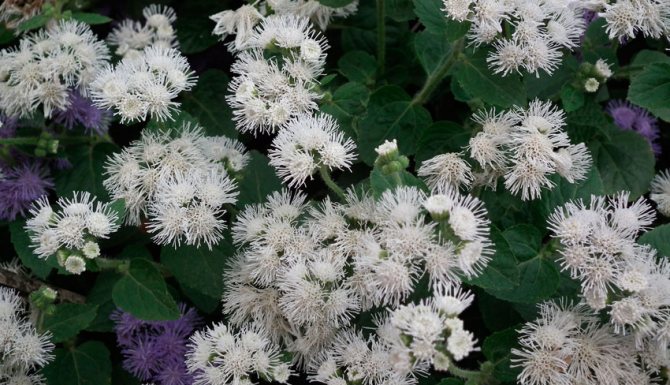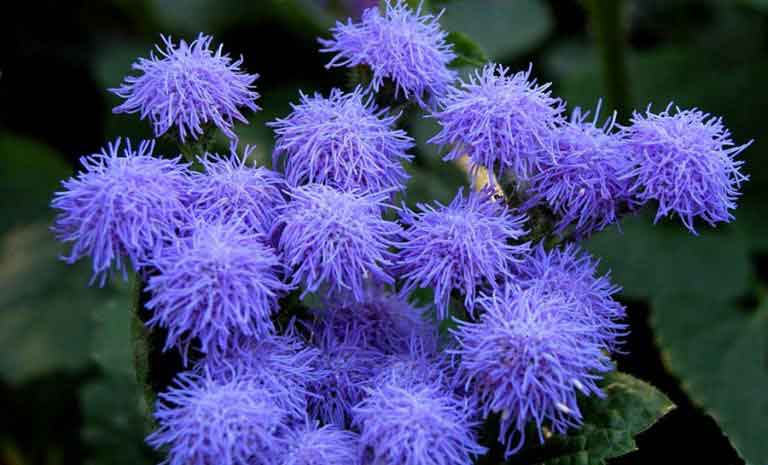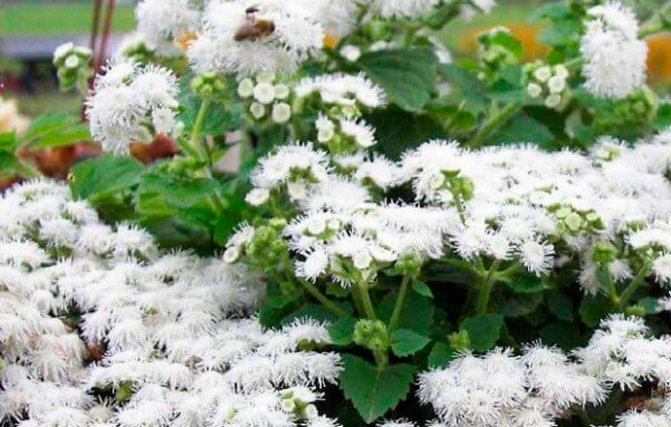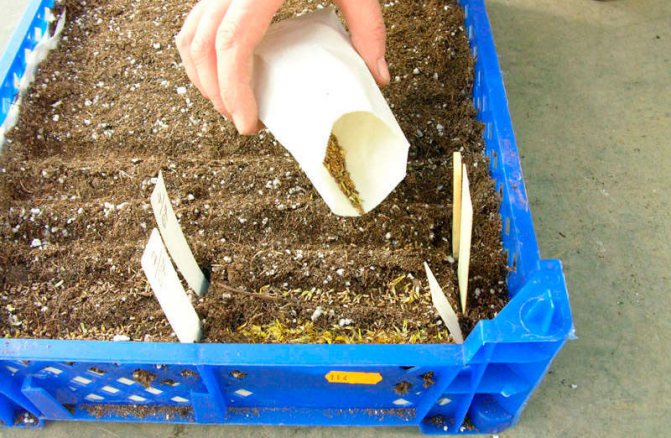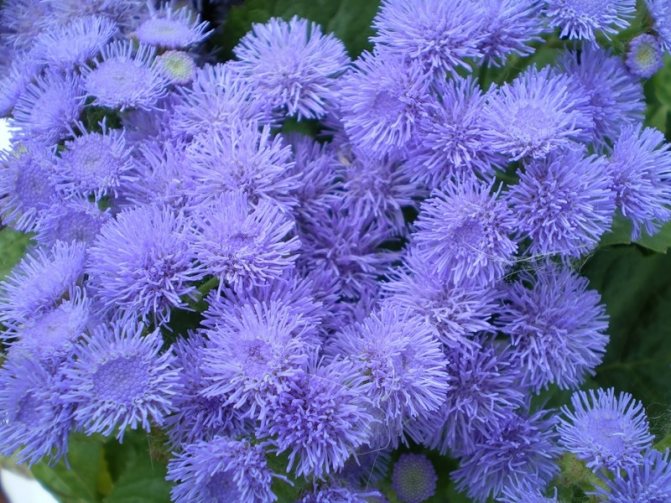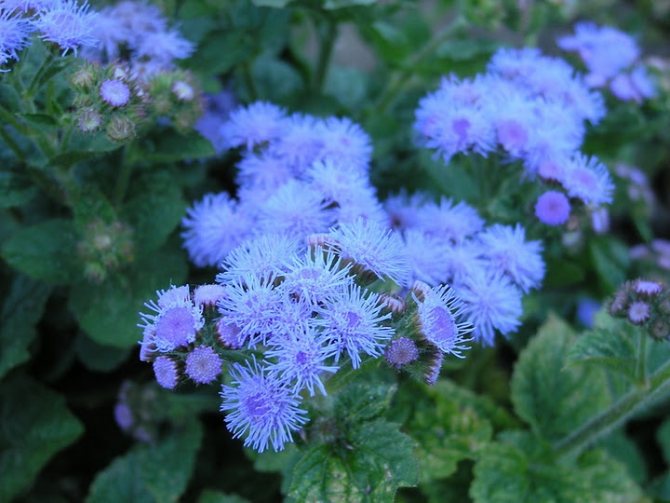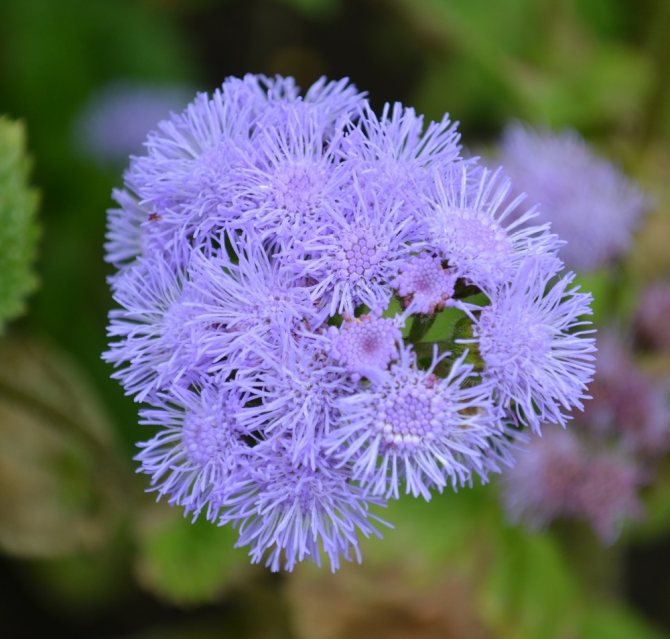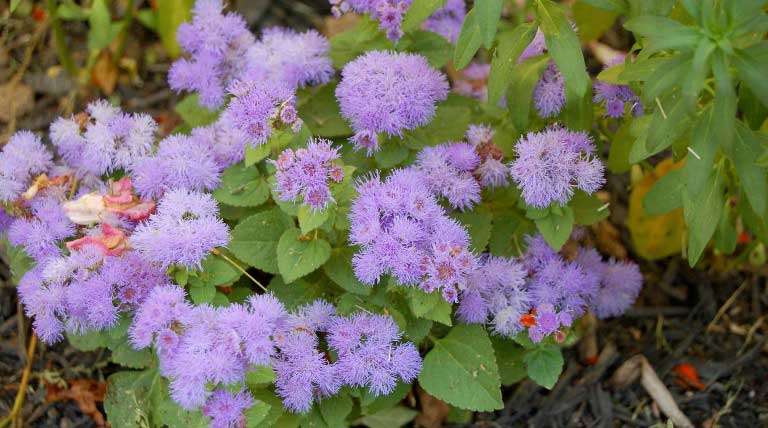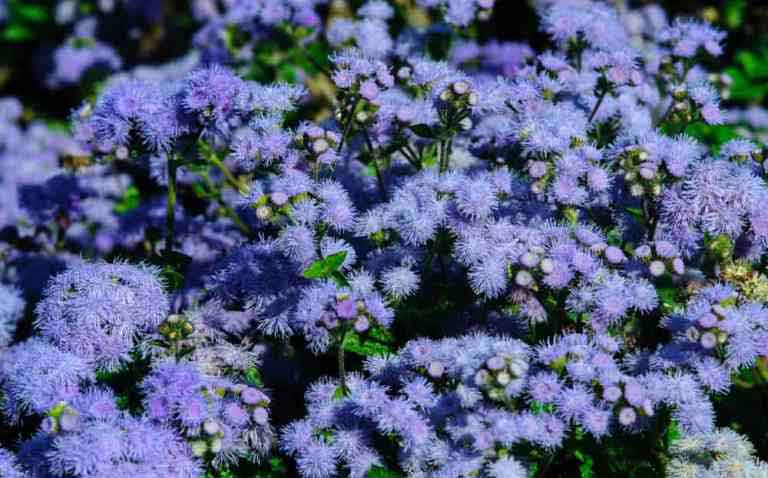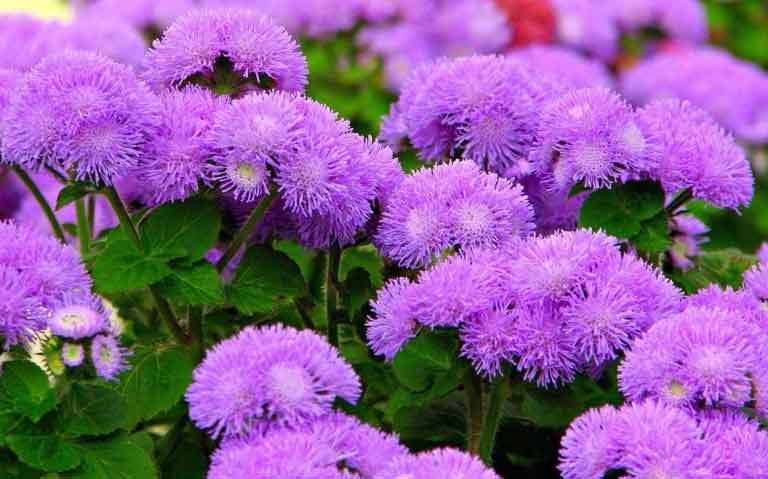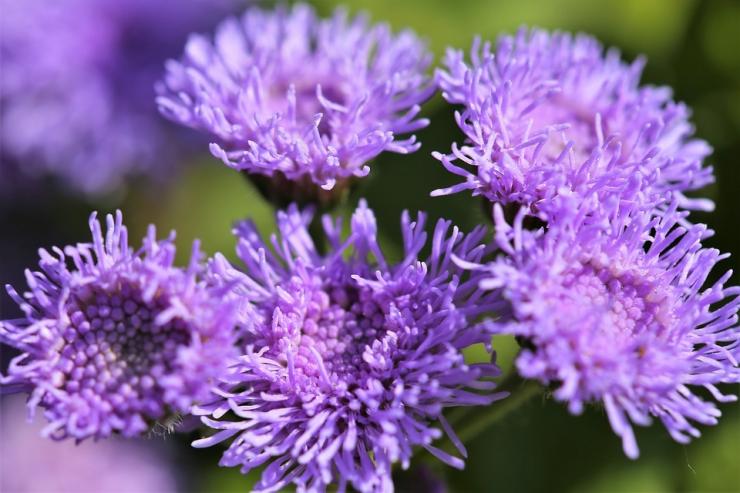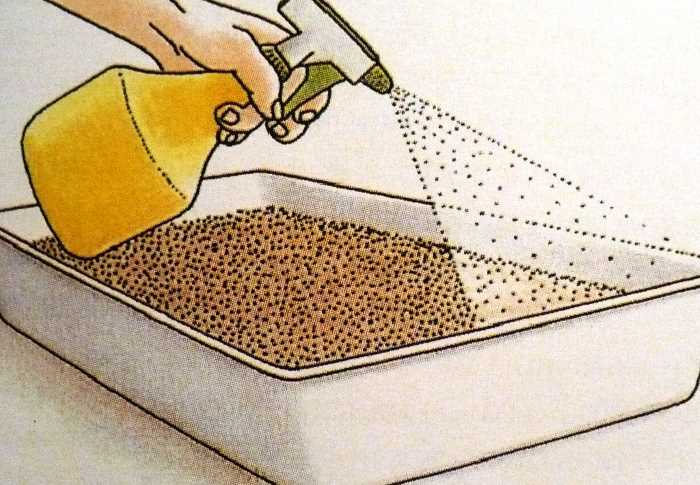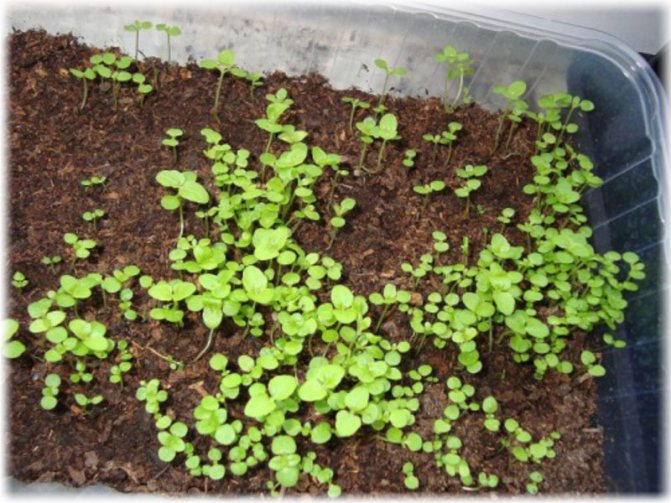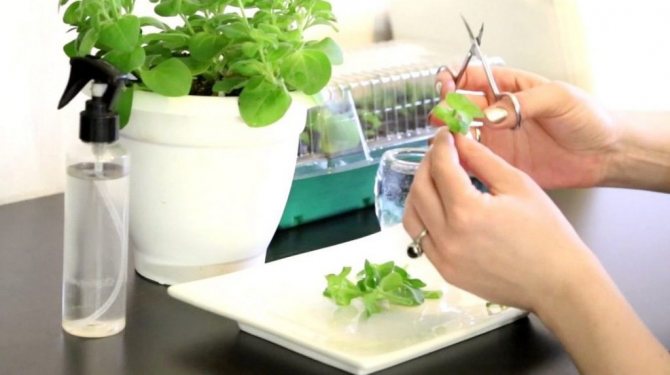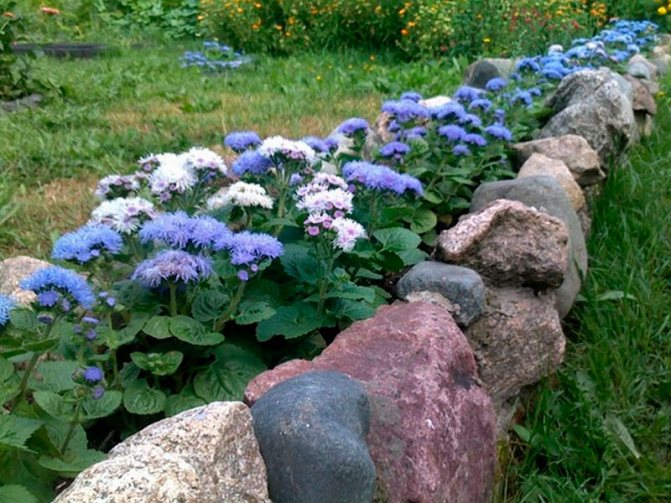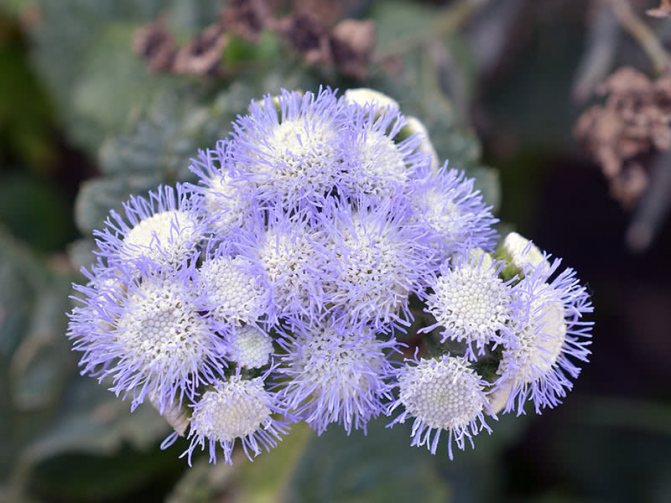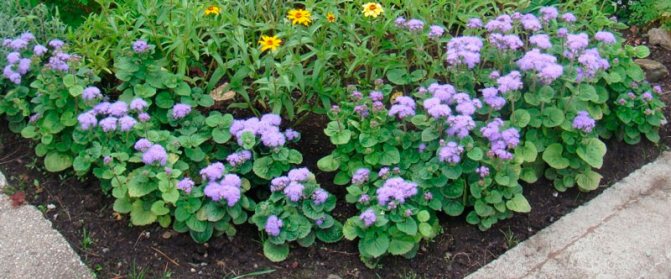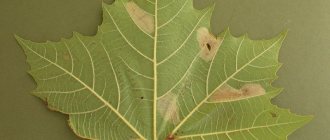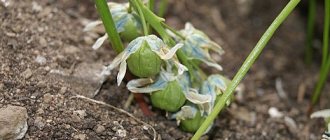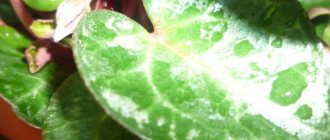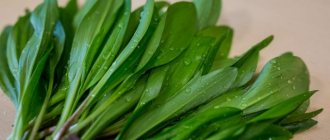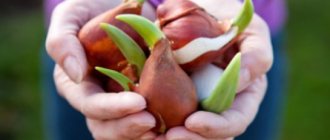Compact and lush ageratum bushes will adorn any flower bed or flower garden. Unpretentiousness in care, an abundance of colors and a long flowering period ensured its continued popularity among gardeners and landscape designers. How to plant ageratum with seedlings correctly, what nuances you need to pay attention to and what mistakes to avoid is described in the material below.
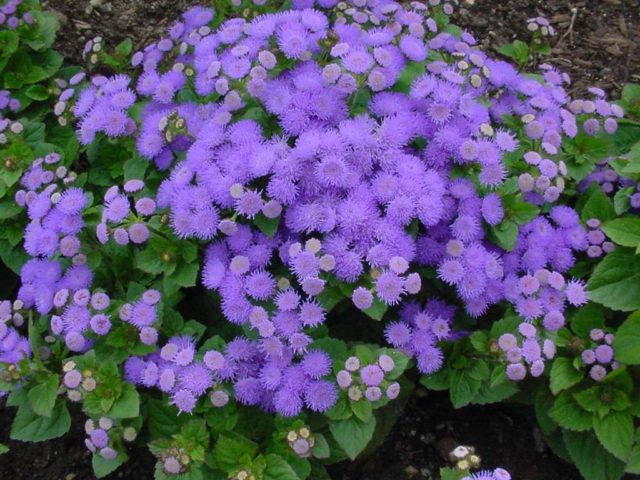
Description and features of the ageratum
The plant of the Aster family is a bush up to 60 cm high, with triangular or diamond-shaped leaves, in some species of ageratum they have an oval shape. Numerous erect elastic stems are pubescent, on each a paniculate peduncle is formed. Complex corymbose inflorescences of small buds are collected in baskets from 1 to 1.5 cm. Depending on the variety, the petals are painted in white, pink, yellow, blue, purple. When the plant is pollinated, an elongated pentahedral wedge-shaped fruit is formed - an achene, in which a dozen small seeds are located.
The perennial does not tolerate subzero temperatures; in the cold season it continues to grow in greenhouse or indoor conditions. The flowering period begins in 2–2.5 months from the emergence of seedlings, and continues until frost.
How to collect seeds for future planting?


ageratum and marigolds in lagandshaft design photo
Seeds are best harvested immediately after the plant has finished flowering. This happens about the second to third week after the flowers appear. The main thing is that the flowers are pollinated and give seeds. With this, however, problems usually do not arise, since the ageratum is willingly pollinated by bumblebees and bees. The flower seeds are very small and elongated. They are also very light, in a gram they can be up to 6-7 thousand. The collected seeds should be brown with a light shade.
It is best to store seeds in a cool dry place
For this purpose, paper or fabric bags are shown, since future plants in plastic bags can suffocate, which will negatively affect their germination.
It can be concluded that ageratum is an attractive, highly decorative flower, rather easy to care for. The main difficulty in caring for ageratum is that all stages of planting and watering must be performed correctly and in a timely manner. With proper care, everything practically comes down to timely watering, weeding from weeds. Plants will thank the owner with luxurious bright flowers.
Ageratum varieties
For landscape design, many varieties of flowers have been bred. Descriptions of varieties popular in Russia are given in the table.
| Variety name | Bush height (cm) / leaf shape | Bud color |
| Houston (Mexican) | 50 / triangular. | Light blue. |
| Alba | 20 / diamond-shaped. | Snow white. |
| Blue mink (dry variety) | 20-25 / rounded. | Deep blue. |
| Bavaria | 30 / in the form of a triangle. | The center of the baskets is light blue, along the edges are pale blue buds. |
| Blue bouquet | 45 / triangular. | Light or dark blue. |
| White ball (creeping variety) | 20 / rounded. | Milky white or snow white. |
| Pink fire | 60 / oval. | Delicate and bright pink. |
| North Sea | 15 / triangular. | Dark violet. |
| Alyssum (golden autumn) | 15 / oblong-wedge-shaped. | Sunny yellow. |


Growing ageratum from seeds
The plant loves neutral soil with a low organic content, humus should be no more than a quarter. When self-preparing the soil for growing seeds, sod, leafy soil, humus, river sand are mixed in equal proportions. For planting, separate pots or a common planting container are prepared, or peat tablets with a diameter of up to 15 cm. Seeds are planted in open ground when the soil warms up to + 15 ° C. The seed ripens naturally only in warm regions.
Sowing ageratum seeds
The planting material is pre-soaked in a solution of biostimulants. They have a disinfecting effect and ensure stable plant growth. Sowing is carried out to a depth of 1.5 cm into moist soil spilled with a weak solution of manganese. Seedlings appear in 10-14 days. To accelerate germination, the container is tightened with a film, removed to a warm place for a week. Recommended germination mode up to +25 ° C.
Seedlings of ageratum
After the appearance of three full-fledged leaves, the seedlings from the common planting tank must be transplanted into separate pots by picking. The shoot is pinched to stimulate branching when there are at least 6 leaves on it. It is watered moderately every three days. With high humidity - once every 5 days. Root feeding is carried out two weeks before planting.
It is best to use complex fertilizers "Agricola" for indoor flowers or succulents. At this time, the seedlings are prepared for planting in open ground.
The shoots are hardened: they are taken out to the balcony, loggia, if the air is warmed up to + 10-12 ° C. First, for 15–20 minutes, then the time interval is increased. If it is not very cool at night, leave the seedlings overnight.
Planting ageratum in open ground
For ageratum, illuminated areas are chosen where there is no close occurrence of groundwater. In low-lying areas, drainage is first done so that the roots of the plant do not rot. In the second half of May, when there is no threat of recurrent frosts, the seedlings can be transferred to open ground. Planting of 6–8 week old seedlings is carried out by transferring them into prepared holes. They are well loosened, spilled with a pink solution of manganese. The distance between the bushes is from 10 to 15 cm. Ageratum is arranged in groups, linearly or staggered, depending on the landscape project. Flowers tolerate well the neighborhood with vegetable crops, perennial early flowers, in which a rest period begins at the end of June.
When to plant ageratum for seedlings
Since the plant cannot withstand low temperatures, it is planted in a flower bed after warm weather sets in. To obtain early and long-lasting flowering, the plant is grown through seedlings. Sowing dates depend on the region of growing ageratum from seeds. When to plant by region:
- in the middle lane and the Moscow region, sowing is carried out in early - mid-March;
- in the south, Ageratum can be sown in early March.
By the time the ageratum is placed on the flower bed, the plant should have several ready-made open buds.
Sowing dates of ageratum according to the lunar calendar 2019
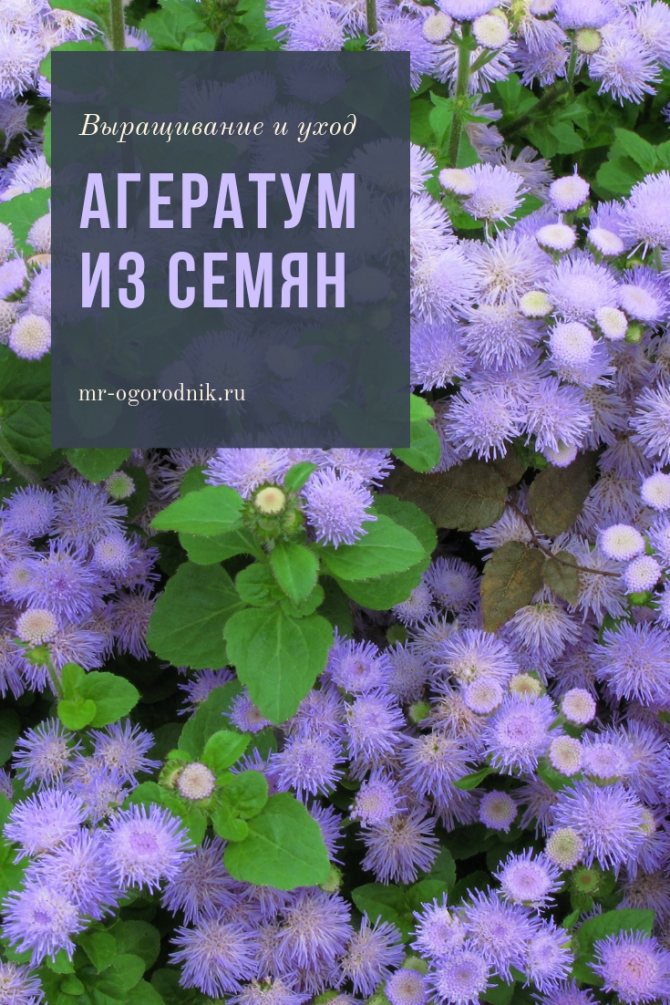

Following the recommendations of the Lunar calendar while working with plants helps to get friendly and powerful seedlings, earlier and more luxuriant flowering.
Favorable days for sowing ageratum for seedlings in the spring of 2019:
- February - 19-20;
- March - 12-17, 19-20;
- April - 6-8, 11-13, 15-17, 29, 30.
There are dates when tampering with plants will harm them. These are the days of the Full Moon and New Moon. An unfavorable period lasts 2-3 days, at this time you should refrain from sowing, transplanting, pinching plants.
In 2020, unfavorable days fall on the following dates:
- 6, 7 and 21 March;
- April 5 and 19;
- May 5 and 19;
- June 3, 4 and 17.
Outdoor Ageratum Care
Like all asters, ageratum is unpretentious to soils, does not require constant care.Basic rules of care:
- Watering. It is important not to overdo it, many varieties are drought-resistant, react painfully to excess moisture, and begin to get sick. When the earthen coma dries up, the plant withers, forms fewer buds.
- Top dressing. An excess of organic matter leads to an increase in green mass, a decrease in budding. Mineral phosphate, potassium and calcium fertilizers are applied no more than once a month. It is better to use complex formulations. It is strictly forbidden to feed with slurry, the plant can die. On fertile soils, it is enough to mulch the soil with humus.
- Pruning. For abundant flowering, it is necessary to remove the set testicles. In place of one cut off inflorescence, new flower stalks are formed. The bush becomes lush, decorated.
Ageratum after flowering, growing at home
Ageratum is a thermophilic plant, but when cool nights come, when the temperature does not rise above +5 ° C, the plant dies. It is adversely affected by the large contrast between night and day temperatures. Before the first frost appears on the soil surface, the plant can be transferred to the greenhouse, it will continue to delight with buds. The most beautiful undersized and medium-sized bushes are transplanted into pots or flowerpots for winter cultivation. To continue flowering, it is moved to a winter garden or apartment. Choose a well-lit place for him. Transplant the flower into a large pot with a large clod of earth. Drainage up to 5 cm high is laid from below.
At home, in a conservatory or greenhouse, the ageratum will continue to bloom until the New Year, and sometimes even after the holiday. When keeping ageratum at home, care consists in regular moderate watering so that the earthen lump does not dry out.
It is important to avoid stagnant water, especially if the apartment is cool. Three times a season, the plant needs fertilizing with a mineral complex with a minimum content of nitrogen components. Fertilizers are diluted according to the instructions, the volume of water is doubled. A ready-made solution is used for watering in the spring, during the period of active flowering and in the fall, when the buds of the next year are laid.
In winter, when there is a short daylight hours, the flower rests, gaining strength for spring flowering. In spring, it releases buds again, blooms profusely. At home, the bush grows up to three years, then it must be divided or transplanted into a large planting container.
For growing in plots, cuttings are cut from the overwintered plant. They fully replace seedlings. You can plant the plant itself in the ground for the summer period, and then transplant it into a pot again in the fall.
The main problems and methods of solving them
It is very important that when growing ageratum, those plants that are able to drown out this flower do not grow nearby. After all, they are able not only to harm the plant with their root system, but also to create an intense shadow that will negatively affect the decorative appearance of the flower.
Be very careful with watering. If the soil is waterlogged, rot may develop. If it is too dry, then, most likely, a spider mite will actively multiply on the bush. That is why the amount of water must be sufficient.
Vegetative propagation
Ageratum, which is dug up in the fall for growing at home, is propagated by cuttings. They are harvested in early spring with sanitary pruning of the bush. 2-3 internodes are left on each. Shoots are cut off, which have formed roots from contact with the ground.


Propagation by cuttings is much more effective than growing seedlings. They take root well, bloom early. Cutting planting technology:
- it is advisable to treat the cut with a biostimulator "Kornevin" to accelerate the formation of the root system;
- the shoot is buried in the prepared soil to a depth of 10-15 mm;
- the soil is well shed;
- create tropical conditions - cover the planting with a transparent container (cut off with a plastic bottle or glass jar);
- when three new leaves appear, the cutting can be transplanted into a garden bed or flowerpot.
The first few days after transplanting, the shoots are protected from direct sunlight in order to retain maximum moisture in the soil.
Sowing seeds for germination
In order to grow strong and healthy seedlings at home, purchased (or pre-harvested) seed is planted in pre-prepared boxes or separate cups filled with a suitable soil composition. The best period for this is mid-March - mid-April. But these terms are averaged, since it is necessary to take into account the specifics of each region:
- In the northern regions - start sowing from April 10. But no later than the 20th of the same month.
- In the middle lane, the planting of seeds begins from the end of March, but no later than April 15.
- In the southern regions, we prepare seedlings, starting from mid-March.
Mr. Dachnik informs: diseases and pests of ageratum
The plant begins to heal at the first sign of illness or insect invasion. Signs of damage to the aggregatum, ways to eliminate them are grouped in a table.
| Problem | Signs | Cause | Remedy |
| Root rot | The plant wilts, the leaves wither. | Stagnation of moisture in the soil. | Fitosporin is introduced into the soil, watering is reduced, and drainage is made around the plantings. |
| Bacterial wilting | The stem softens, and brown furrows appear on it. | High humidity in hot weather. | Treatment with an antifungal drug Fitolavin; watering with potassium permanganate solution; feeding with micronutrient fertilizer Baikal-EM. |
| Cucumber mosaic | Yellow spots appear on the leaves. | The spread of the virus by insects. | Prevention against aphids, removal of damaged shoots. |
| Whitefly | Small white midges are visible around the bush; they nest on the back of the leaves. | High humidity in hot weather, confined space (whitefly often infects aggregatum in a greenhouse, winter garden). | Treatment with insecticides, antifungal drugs (sooty fungus develops on the excrements of the whitefly) |
| Spider mite | Snares appear on the plant, they braid the tops of young shoots. | Dry, hot weather. | Pluck the affected shoots, spray them with pesticides against insects. |
| Nematodes | The flower develops poorly, internodes thicken, the affected parts of the stem darken. | Small earthworms of the nematode class. | Dig the affected bush to protect the neighboring ones. |
| Winter scoops | Eaten leaves. | Leaf-eating caterpillars. | Manual collection of scoops, they are activated in the evening, the device of traps. |
Aggregatum is characterized by diseases affecting vegetable crops. For preventive purposes, treatment is carried out against pests and diseases in the spring.

